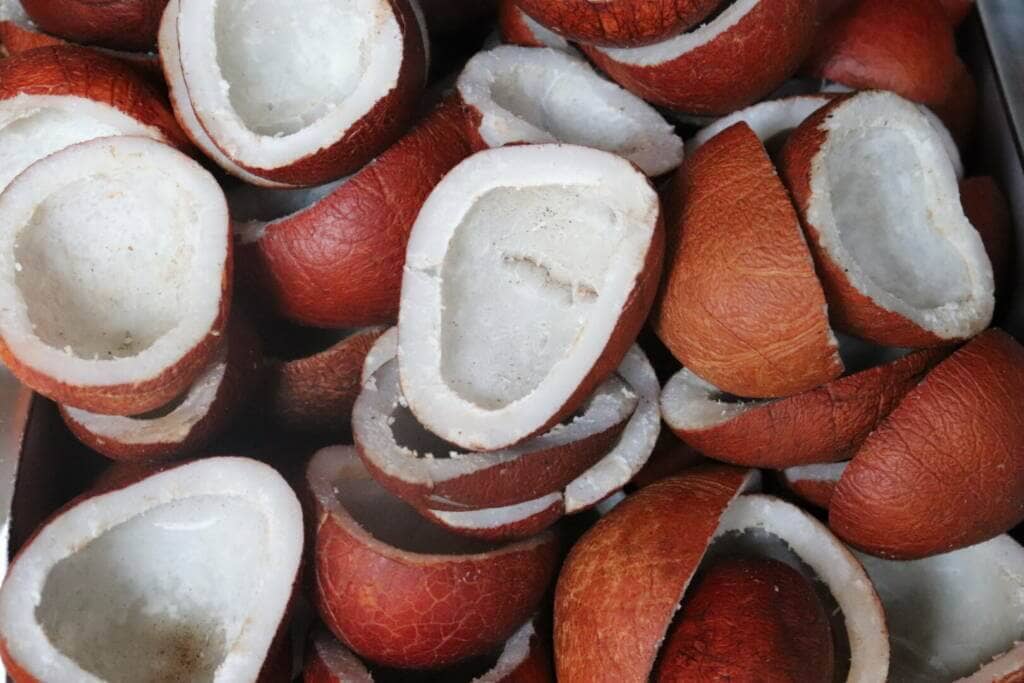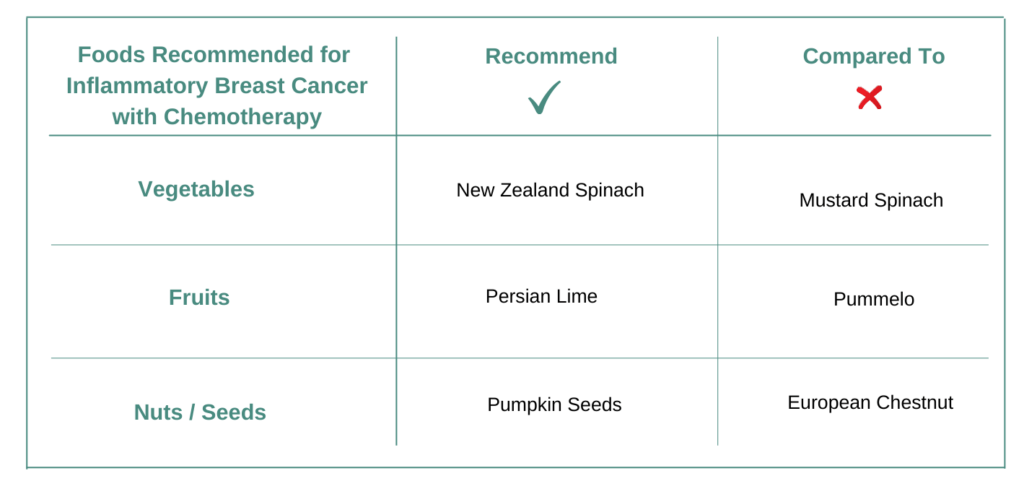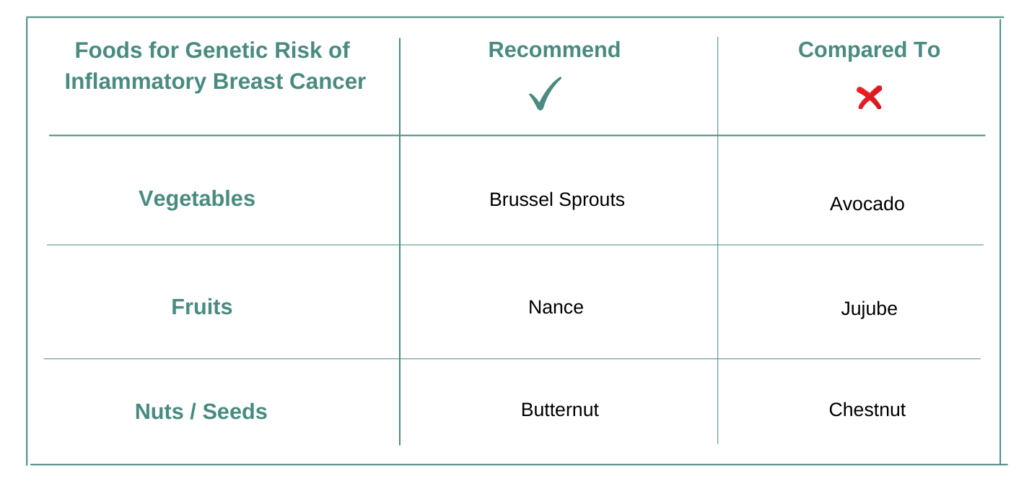Introduction
Foods for Inflammatory Breast Cancer should be personalized for each individual and also must adapt when cancer treatment or tumor genetic change. The personalization and adaptation must consider all the active ingredients or bioactives contained in different foods with respect to cancer tissue biology, genetics, treatments, lifestyle conditions and diet preferences. Hence while nutrition is one of the very important decisions for a cancer patient and individual at risk of cancer to make – how to choose foods to eat is not an easy task.
Inflammatory breast cancer is a rare and aggressive form of breast cancer that can present with a variety of symptoms, including a distinctive rash or red spot on the breast. Accurate diagnosis of inflammatory breast cancer is crucial, as it requires immediate and aggressive treatment. Inflammatory breast cancer may be identified through a combination of physical examination, mammogram, ultrasound, and biopsy. Survival rates for inflammatory breast cancer vary depending on various factors, including the stage of the cancer and response to treatment. Comprehensive treatment options for inflammatory breast cancer typically include chemotherapy, radiation therapy, and targeted therapies, tailored to the individual patient. While the exact cause of inflammatory breast cancer is unknown, research suggests that a combination of genetic and environmental factors may contribute to its development. It is important to be aware of the risk factors associated with inflammatory breast cancer, such as age, gender, and family history. Understanding the pathophysiology and progression of inflammatory breast cancer helps guide treatment decisions and improve patient outcomes. Ongoing clinical trials aim to explore new treatments and enhance our understanding of this aggressive form of breast cancer. By staying informed and seeking appropriate medical care, individuals affected by inflammatory breast cancer can access the latest treatments and optimize their chances of survival and improved quality of life.
For Inflammatory Breast Cancer does it matter what vegetables, fruits, nuts, seeds one eats?
A very common nutrition question asked by cancer patients and individuals at-genetic risk of cancer is – for cancers like Inflammatory Breast Cancer does it matter what foods I eat and which I do not? Or if I follow a plant-based diet is that enough for cancer like Inflammatory Breast Cancer?
For example does it matter if vegetable New Zealand Spinach is consumed more compared to Mustard Spinach? Does it make any difference if fruit Pummelo is preferred over Persian Lime? Also if similar choices are made for nuts/seeds like Pumpkin Seeds over European Chestnut and for pulses like Black-eyed Pea over Hyacinth Bean. And if what I eat matters – then how does one identify foods which are recommended for Inflammatory Breast Cancer and is it the same answer for everyone with the same diagnosis or genetic risk?
Yes! Foods you eat matters for Inflammatory Breast Cancer!
Food recommendations may not be the same for everyone and can be different even for the same diagnosis and genetic risk.

All foods (vegetables, fruits, nuts, seeds, pulses, oils etc.) and nutritional supplements are made up of more than one active molecular ingredient or bio-actives in different proportions and quantities. Each active ingredient has a unique mechanism of action – which can be activation or inhibition of different biochemical pathways. Simply stated foods and supplements which are recommended are those which do not cause an increase of molecular drivers of cancer but reduce them. Else those foods should not be recommended. Foods contain multiple active ingredients – hence when evaluating foods and supplements you need to consider the impact of all active ingredients cumulatively rather than individually.
For example Pummelo contains active ingredients Curcumin, Naringenin, Hesperetin, Eugenol, Quercetin. And Persian Lime contains active ingredients Curcumin, Hesperetin, Eugenol, Isoliquiritigenin, Daidzein and possibly others.
A common mistake made when deciding and choosing foods to eat for Inflammatory Breast Cancer – is to evaluate only selected active ingredients contained in foods and ignore the rest. Because different active ingredients contained in foods may have opposing effects on cancer drivers – you cannot cherry pick active ingredients in foods and supplements for making a nutrition decision for Inflammatory Breast Cancer.
YES – FOOD CHOICES MATTER FOR CANCER. NUTRITION DECISIONS MUST CONSIDER ALL ACTIVE INGREDIENTS OF FOODS.
Skills Needed for Nutrition Personalization for Inflammatory Breast Cancer?
Personalized nutrition for cancers like Inflammatory Breast Cancer consists of recommended foods / supplements; not recommended foods / supplements with example recipes which prioritize use of recommended foods. An example of personalized nutrition can be seen at this link.
Deciding which foods are recommended or not is extremely complicated, requiring expertise in Inflammatory Breast Cancer biology, food science, genetics, biochemistry along with good understanding of how cancer treatments work and associated vulnerabilities by which the treatments could stop being effective.
MINIMUM KNOWLEDGE EXPERTISE NEEDED FOR NUTRITION PERSONALIZATION FOR CANCER ARE: CANCER BIOLOGY, FOOD SCIENCE, CANCER TREATMENTS AND GENETICS.
Foods to Eat After Cancer Diagnosis!
No two cancers are the same. Go beyond the common nutrition guidelines for everyone and make personalized decisions about food and supplements with confidence.
Characteristics of cancers like Inflammatory Breast Cancer
All cancers like Inflammatory Breast Cancer can be characterized by a unique set of biochemical pathways – the signature pathways of Inflammatory Breast Cancer. Biochemical pathways like Epithelial to Mesenchymal Transition, PI3K-AKT-MTOR Signaling, Adherens junction, Growth Factor Signaling are part of the signature definition of Inflammatory Breast Cancer. Each individual’s cancer genetics can be different and hence their specific cancer signature could be unique.
The treatments which are effective for Inflammatory Breast Cancer need to be cognizant of the associated signature biochemical pathways for each cancer patient and individual at genetic risk. Therefore different treatments with different mechanisms of actions are effective for different patients. Similarly and for the same reasons foods and supplements need to be personalized for each individual. Hence some foods and supplements are recommended for Inflammatory Breast Cancer when taking cancer treatment Radiation, and some foods and supplements are not recommended.
Sources like cBioPortal and many others provide population representative patient anonymized data from clinical trials for all cancer indications. This data consists of clinical trial study details like sample size / number of patients, age groups, gender, ethnicity, treatments, tumor site and any genetic mutations.
CDH1, ERBB2, RHOA, RUNX1 and TET2 are the top ranked reported genes for Inflammatory Breast Cancer. CDH1 is reported in 100.0 % of the representative patients across all clinical trials. And ERBB2 is reported in 100.0 %. The combined population patient data cover ages from to . 0.0 % of the patient data are identified as men. The Inflammatory Breast Cancer biology along with reported genetics together define the population represented signature biochemical pathways for this cancer. If the individual cancer tumor genetics or genes contributing to the risk are also known then that should also be used for nutrition personalization.
NUTRITION CHOICES SHOULD MATCH WITH EACH INDIVIDUAL’S CANCER SIGNATURE.
Food and Supplements for Inflammatory Breast Cancer
For Cancer Patients
Cancer patients on treatment or on palliative care need to make decisions on food and supplements – for the needed dietary calories, for managing any treatment side effects and also for improved cancer management. All plant-based foods are not equal and choosing and prioritizing foods which are personalized and customized to ongoing cancer treatment is important and complicated. Here are some examples providing guidelines for making nutrition decisions.
Choose Vegetable NEW ZEALAND SPINACH or MUSTARD SPINACH
Vegetable New Zealand Spinach contains many active ingredients or bioactives such as Curcumin, Eugenol, Quercetin, Lycopene, Isoliquiritigenin. These active ingredients manipulate various biochemical pathways like Epithelial to Mesenchymal Transition and PI3K-AKT-MTOR Signaling and others. New Zealand Spinach is recommended for Inflammatory Breast Cancer when ongoing cancer treatment is Radiation. This is because New Zealand Spinach modifies those biochemical pathways which have been scientifically reported to sensitize the effect of Radiation.
Some of the active ingredients or bioactives in vegetable Mustard Spinach are Curcumin, Eugenol, Lycopene, Isoliquiritigenin, Daidzein. These active ingredients manipulate various biochemical pathways like Epithelial to Mesenchymal Transition and PI3K-AKT-MTOR Signaling and others. Mustard Spinach is not recommended for Inflammatory Breast Cancer when ongoing cancer treatment is Radiation because it modifies those biochemical pathways which make the cancer treatment resistant or less responsive.
VEGETABLE NEW ZEALAND SPINACH IS RECOMMENDED OVER MUSTARD SPINACH FOR Inflammatory Breast Cancer AND TREATMENT Radiation.
Choose Fruit PERSIAN LIME or PUMMELO
Fruit Persian Lime contains many active ingredients or bioactives such as Curcumin, Hesperetin, Eugenol, Isoliquiritigenin, Daidzein. These active ingredients manipulate various biochemical pathways like Epithelial to Mesenchymal Transition and PI3K-AKT-MTOR Signaling and others. Persian Lime is recommended for Inflammatory Breast Cancer when ongoing cancer treatment is Radiation. This is because Persian Lime modifies those biochemical pathways which have been scientifically reported to sensitize the effect of Radiation.
Some of the active ingredients or bioactives in fruit Pummelo are Curcumin, Naringenin, Hesperetin, Eugenol, Quercetin. These active ingredients manipulate various biochemical pathways like Epithelial to Mesenchymal Transition and PI3K-AKT-MTOR Signaling and others. Pummelo is not recommended for Inflammatory Breast Cancer when ongoing cancer treatment is Radiation because it modifies those biochemical pathways which make the cancer treatment resistant or less responsive.
FRUIT PERSIAN LIME IS RECOMMENDED OVER PUMMELO FOR Inflammatory Breast Cancer AND TREATMENT Radiation.
Choose Nut PUMPKIN SEEDS or EUROPEAN CHESTNUT
Pumpkin Seeds contains many active ingredients or bioactives such as Gamma-linolenic Acid, Beta-sitosterol, Linolenic Acid, Oleic Acid, Stigmasterol. These active ingredients manipulate various biochemical pathways like Epithelial to Mesenchymal Transition and PI3K-AKT-MTOR Signaling and others. Pumpkin Seeds is recommended for Inflammatory Breast Cancer when ongoing cancer treatment is Radiation. This is because Pumpkin Seeds modifies those biochemical pathways which have been scientifically reported to sensitize the effect of Radiation.
Some of the active ingredients or bioactives in European Chestnut are Curcumin, Ellagic Acid, Eugenol, Quercetin, Isoliquiritigenin. These active ingredients manipulate various biochemical pathways like Epithelial to Mesenchymal Transition and others. European Chestnut is not recommended for Inflammatory Breast Cancer when ongoing cancer treatment is Radiation because it modifies those biochemical pathways which make the cancer treatment resistant or less responsive.
PUMPKIN SEEDS IS RECOMMENDED OVER EUROPEAN CHESTNUT FOR Inflammatory Breast Cancer AND TREATMENT Radiation.

For Individuals with Genetic Risk of Cancer
The question asked by individuals who have genetic risk of Inflammatory Breast Cancer or familial history is “What Should I Eat Differently from Before?” and how they should choose foods and supplements to manage risks of the disease. Since for cancer risk there is nothing actionable in terms of treatment – decisions of foods and supplements become important and one of the very few actionable things which can be done. All plant-based foods are not equal and based on identified genetics and pathway signature – the choices of food and supplements should be personalized.
Choose Vegetable BRUSSEL SPROUTS or AVOCADO
Vegetable Brussel Sprouts contains many active ingredients or bioactives such as Curcumin, Delphinidin, Lupeol, Isoliquiritigenin, Phloretin. These active ingredients manipulate various biochemical pathways like MAPK Signaling, MYC Signaling, Oncogenic Cancer Epigenetics and PI3K-AKT-MTOR Signaling and others. Brussel Sprouts is recommended for risk of Inflammatory Breast Cancer when associated genetic risk is CDH1. This is because Brussel Sprouts increases those biochemical pathways which counteract the signature drivers of it.
Some of the active ingredients or bioactives in vegetable Avocado are Quercetin, Vitamin D3, Curcumin, Delphinidin, Lupeol. These active ingredients manipulate various biochemical pathways like TGFB Signaling and others. Avocado is not recommended when risk of Inflammatory Breast Cancer when associated genetic risk is CDH1 because it increases the signature pathways of it.
VEGETABLE BRUSSEL SPROUTS IS RECOMMENDED OVER AVOCADO FOR CDH1 GENETIC RISK OF CANCER.
Choose Fruit NANCE or JUJUBE
Fruit Nance contains many active ingredients or bioactives such as Curcumin, Delphinidin, Myricetin, Lupeol, Isoliquiritigenin. These active ingredients manipulate various biochemical pathways like MAPK Signaling, TGFB Signaling, Oncogenic Cancer Epigenetics and PI3K-AKT-MTOR Signaling and others. Nance is recommended for risk of Inflammatory Breast Cancer when associated genetic risk is CDH1. This is because Nance increases those biochemical pathways which counteract the signature drivers of it.
Some of the active ingredients or bioactives in fruit Jujube are Quercetin, Curcumin, Delphinidin, Myricetin, Lycopene. These active ingredients manipulate various biochemical pathways like MAPK Signaling and Oncogenic Cancer Epigenetics and others. Jujube is not recommended when risk of Inflammatory Breast Cancer when associated genetic risk is CDH1 because it increases the signature pathways of it.
FRUIT NANCE IS RECOMMENDED OVER JUJUBE FOR CDH1 GENETIC RISK OF CANCER.
Choose Nut BUTTERNUT or CHESTNUT
Butternut contains many active ingredients or bioactives such as Curcumin, Delphinidin, Myricetin, Lycopene, Lupeol. These active ingredients manipulate various biochemical pathways like MAPK Signaling, RAS-RAF Signaling, Oncogenic Cancer Epigenetics and PI3K-AKT-MTOR Signaling and others. Butternut is recommended for risk of Inflammatory Breast Cancer when associated genetic risk is CDH1. This is because Butternut increases those biochemical pathways which counteract the signature drivers of it.
Some of the active ingredients or bioactives in Chestnut are Ellagic Acid, Curcumin, Delphinidin, Myricetin, Lycopene. These active ingredients manipulate various biochemical pathways like WNT Beta Catenin Signaling, Cytoskeletal Dynamics and Epithelial to Mesenchymal Transition and others. Chestnut is not recommended when risk of Inflammatory Breast Cancer when associated genetic risk is CDH1 because it increases the signature pathways of it.
BUTTERNUT IS RECOMMENDED OVER CHESTNUT FOR CDH1 GENETIC RISK OF CANCER.

In Conclusion
Foods and Supplements chosen are important decisions for cancers like Inflammatory Breast Cancer. Inflammatory Breast Cancer patients and individuals with genetic-risk always have this question: “What foods and nutritional supplements are recommended for me and which are not?” There is a common belief which is a misconception that all plant-based foods could be beneficial or not but would not be harmful. Certain foods and supplements can interfere with cancer treatments or promote molecular pathway drivers of cancer.
There are different types of cancer indications like Inflammatory Breast Cancer, each with different tumor genetics with further genomic variations across each individual. Further every cancer treatment and chemotherapy has a unique mechanism of action. Each food like New Zealand Spinach contains various bioactives in different quantities, which have an impact on different and distinct sets of biochemical pathways. The definition of personalized nutrition is individualized food recommendations for the cancer indication, treatments, genetics, lifestyle and other factors. Nutrition personalization decisions for cancer require knowledge of cancer biology, food science and an understanding of different chemotherapy treatments. Finally when there are treatment changes or new genomics is identified – the nutrition personalization needs re-evaluation.
The addon nutrition personalization solution makes the decision making easy and removes all the guesswork in answering the question, “What foods should I choose or not choose for Inflammatory Breast Cancer?”. The addon multi-disciplinary team includes cancer physicians, clinical scientists, software engineers and data scientists.
Personalized Nutrition for Cancer!
Cancer changes with time. Customize and modify your nutrition based on cancer indication, treatments, lifestyle, food preferences, allergies and other factors.
References
- Summit 2018
- HER kinase inhibition in patients with HER2- and HER3-mutant cancers.
- Vitamin C enhances epigenetic modifications induced by 5-azacytidine and cell cycle arrest in the hepatocellular carcinoma cell lines HLE and Huh7.
- Pelargonidin induces antitumor effects in human osteosarcoma cells via autophagy induction, loss of mitochondrial membrane potential, G2/M cell cycle arrest and downregulation of PI3K/AKT signalling pathway.
- Hesperetin Promotes Cisplatin-Induced Apoptosis of Gastric Cancer In Vitro and In Vivo by Upregulating PTEN Expression.
- Gamma linolenic acid suppresses hypoxia-induced gastric cancer cell growth and epithelial-mesenchymal transition by inhibiting the Wnt/b-catenin signaling pathway.
- β-Sitosterol and Gemcitabine Exhibit Synergistic Anti-pancreatic Cancer Activity by Modulating Apoptosis and Inhibiting Epithelial-Mesenchymal Transition by Deactivating Akt/GSK-3β Signaling.
- Growth stimulation of human pulmonary adenocarcinoma cells and small airway epithelial cells by beta-carotene via activation of cAMP, PKA, CREB and ERK1/2.
- Functional lipidomics: Palmitic acid impairs hepatocellular carcinoma development by modulating membrane fluidity and glucose metabolism.
- Brassinin Represses Invasive Potential of Lung Carcinoma Cells through Deactivation of PI3K/Akt/mTOR Signaling Cascade.
- Melatonin and vitamin D3 synergistically down-regulate Akt and MDM2 leading to TGFβ-1-dependent growth inhibition of breast cancer cells.
